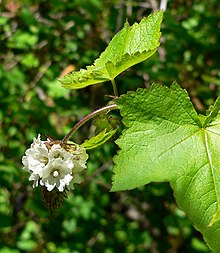| Sidalcea | |
|---|---|

| |
| Sidalcea malachroides | |
| Scientific classification | |
| Kingdom: | Plantae |
| Clade: | Tracheophytes |
| Clade: | Angiosperms |
| Clade: | Eudicots |
| Clade: | Rosids |
| Order: | Malvales |
| Family: | Malvaceae |
| Subfamily: | Malvoideae |
| Tribe: | Malveae |
| Genus: | Sidalcea A. Gray ex Benth. |
| Species | |
|
See text | |
Sidalcea is a genus (approx. 25 species[1][2]) of the botanical family Malvaceae. It contains several species of flowering plants known generally as checkerblooms or checkermallows, or prairie mallows in the United Kingdom. They can be annuals or perennials, some rhizomatous. They are native to West and Central North America.
In mid- to late summer the clumps of toothed basal leaves produce erect flowering stems, with 5-petalled mallow-type flowers in terminal racemes, in shades of pink, white and purple.[3]
Sidalcea is generally diploid (2n = 20), but polyploidy (4n, 6n) also occurs.[1]
Annuality appears to have evolved multiple times (4+) within this genus, although an ancestral annual state with annual paraphyly is also possible. Further, evolution rates within annual Sidalcea lineages appear to be faster than those of perennial lineages, at least when examining nuclear ribosomal DNA (internal and external transcribed spacer regions).[1][2]
Selected species:
(A = annual, P = perennial[1])
- Sidalcea asprella[1] (P)
- Sidalcea calycosa – annual checkerbloom (A)
- Sidalcea campestris – meadow checkermallow (P)
- Sidalcea candida – white checkerbloom (P)
- Sidalcea covillei – Owens Valley sidalcea (P)
- Sidalcea cusickii – Cusick's checkermallow (P)
- Sidalcea diploscypha – fringed checkerbloom (A)
- Sidalcea glaucescens – waxy checkerbloom (P)
- Sidalcea gigantea[1] (P)
- Sidalcea hartwegii – valley checkerbloom (A)
- Sidalcea hendersonii – Henderson's checkermallow (P)
- Sidalcea hickmanii – chaparral checkerbloom (P)
- Sidalcea hirsuta – hairy checkerbloom (A)
- Sidalcea hirtipes[1] - hairy-stemmed checker-mallow[4] (P)
- Sidalcea keckii – Keck's checkerbloom (A)
- Sidalcea malachroides – mapleleaf checkerbloom (P)
- Sidalcea malviflora – dwarf checkerbloom
- Sidalcea multifida[1] (P)
- Sidalcea nelsoniana – Nelson's checkermallow (threatened)
- Sidalcea neomexicana – Salt Spring checkerbloom (P)
- Sidalcea oregana – Oregon checkerbloom (miniature hollyhock)
- Sidalcea oregana var. calva – Wenatchee Mountains checkermallow
- Sidalcea pedata – birdfooted checkerbloom, Big Bear checkerbloom (P)
- Sidalcea ranunculacea – marsh checkerbloom
- Sidalcea reptans – Sierra checkerbloom
- Sidalcea robusta – Butte County checkerbloom (P)
- Sidalcea stipularis – Scadden Flat checkerbloom (P)
- Sidalcea virgata[1] (P)
Garden cultivars are hybrids between S. candida and S. malviflora. The perennial cultivars "Elsie Heugh",[5] 'Oberon'[6] and "William Smith"[7] have gained the Royal Horticultural Society's Award of Garden Merit.[8]
- ^ a b c d e f g h i Andreasen, Katarina; Baldwin, Bruce G. (2003-03-01). "Reexamination of relationships, habital evolution, and phylogeography of checker mallows (Sidalcea; Malvaceae) based on molecular phylogenetic data". American Journal of Botany. 90 (3): 436–444. doi:10.3732/ajb.90.3.436. ISSN 0002-9122. PMID 21659137.
- ^ a b Andreasen, K.; Baldwin, B. G. (2001-06-01). "Unequal evolutionary rates between annual and perennial lineages of checker mallows (Sidalcea, Malvaceae): evidence from 18S-26S rDNA internal and external transcribed spacers". Molecular Biology and Evolution. 18 (6): 936–944. doi:10.1093/oxfordjournals.molbev.a003894. ISSN 0737-4038. PMID 11371581.
- ^ RHS A-Z encyclopedia of garden plants. United Kingdom: Dorling Kindersley. 2008. p. 1136. ISBN 978-1405332965.
- ^ "Sidalcea hirtipes C.L. Hitchc. hairy-stemmed checker-mallow" (PDF). Hitchcock 1957 referenced. Washington State Department of Natural Resources. Retrieved March 3, 2016.
{{cite web}}: CS1 maint: others (link) - ^ "RHS Plant Selector Sidalcea 'Elsie Heugh' AGM / RHS Gardening". Apps.rhs.org.uk. Retrieved 2021-03-09.
- ^ "Sidalcea 'Oberon'". RHS. Retrieved 5 March 2021.
- ^ "RHS Plant Selector Sidalcea 'William Smith' AGM / RHS Gardening". Apps.rhs.org.uk. Retrieved 2021-03-09.
- ^ "AGM Plants - Ornamental" (PDF). Royal Horticultural Society. July 2017. p. 97. Retrieved 11 November 2018.